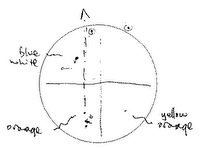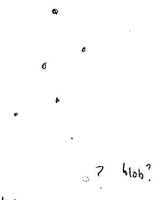
At 12:31am I watched, through the eyepiece, a satellite pass very close to Mizar.
seeing: very good, 8
transparency: could see, with averted vision, 5.0 mag. stars in Ursa Minor
temp: 20°C
pressure: steady
humidity: 70%
wind: nil
I hung out in the driveway for a couple of hours. At 2:30am, the Milky Way was very good.
§
It's been on my list of things to do to get to know more constellations. It then occurred to me to first document ones that I am very familiar with. Here goes:
Ursa Major, Ursa Minor, Cassiopeia, Orion, Andromeda (and the Great Square), Delphinus, Lyra, Cygnus, Boötes, and the Water Jar of Aquarius.
I'm getting comfortable with Aquila, Capricornus, Scorpius, Hercules, and Perseus.
I practiced Taurus and Auriga tonight.
While looking north, I surveyed the northern sky. I'm much more comfortable with Draco now, as it weaves between the bears, coiling around Minor.
§
A very bright satellite moved from Lyra, past the north tip of Cygnus, to the south-east. Wow! Was it the ISS?
I should also have an up-to-date listing of ISS passings in the future... (I've since added this to my "prep" list.)
Also, I did not record the time of this sighting! Duh. Must be better about that in the future... But assuming 1:00am or 2:00am then it was generally from the north-west to the east. Altitude would be almost 90°. Based on data at http://heavens-above.com/ it doesn't look like it was the ISS.
§
Tried chasing some interesting sites within Cassiopeia. What is the blob to the left?

§
Wow, there are lots of bats out.
§
Discouraged, depressed, frustrated, tired, I never even tried for Ceres.
The RedShift software shows asteroids. Might be fun to track some. See daily changes.
§
So then I started working my list of Messier objects (with my cat 'scope). The Moon had set at 1:30am and it was 5 hours until sunrise. I tried for:
- galaxy Messier 81 (M81) in Ursa Major: couldn't find it
- galaxy Messier 101 (M101) in Ursa Major: couldn't find it
- globular cluster Messier 56 (M56) in Lyra: couldn't find it
- open cluster Messier 52 (M52) in Cassiopeia: couldn't see it
- and finally Messier 103 (M103): couldn't see it
I had another 15 on my listed but I just quit.
§
Incredible dew. Everything was soaked. Dripping. So this is 98% humidity.
That I only have dew heaters for one 'scope became a new limitation. I couldn't—like I had envisioned—switch between the cat and newt. In fact, the cat finder scope and newt Telrad became unusable. Do you have to heat the secondary in a newt as well?! If so, how? Also the eyepieces and doubler were dewing up when not in service. I started keeping the 26mm or 18mm, whichever I wasn't using, in my pants hip pocket to keep warm. That worked...
Oh, to have a heated observatory!
I was concerned for the laptop and my palmtop, electrically, and all the moisture. How will I keep them dry in the future? I can stuff the palmtop into a ziploc. But the big machine?
I believe this is what also dissuaded me from doing some star trails photos. If I had set up the camera for a long exposure, I would have had to release the dew heaters to the lens.
There's gotta be a better way... A heated deck? A large heated pad? Fans?
§
I got a little chilled. From the damp and the dropping temperature. I didn't think to bring warmer clothes. Lesson learned. If doing very late or early morning astronomy in the summer, packing for cool to cold weather.


No comments:
Post a Comment